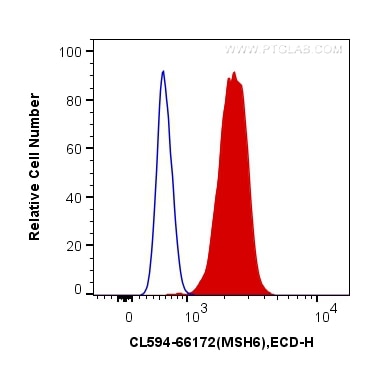- Featured Product
- KD/KO Validated
MSH6 Monoklonaler Antikörper
MSH6 Monoklonal Antikörper für FC (Intra)
Wirt / Isotyp
Maus / IgG2a
Getestete Reaktivität
human
Anwendung
FC (Intra)
Konjugation
CoraLite®594 Fluorescent Dye
CloneNo.
2E10B2
Kat-Nr. : CL594-66172
Synonyme
Geprüfte Anwendungen
| Erfolgreiche Detektion in FC (Intra) | HEK-293-Zellen |
Empfohlene Verdünnung
| Anwendung | Verdünnung |
|---|---|
| Durchflusszytometrie (FC) (INTRA) | FC (INTRA) : 0.40 ug per 10^6 cells in a 100 µl suspension |
| It is recommended that this reagent should be titrated in each testing system to obtain optimal results. | |
| Sample-dependent, check data in validation data gallery | |
Produktinformation
CL594-66172 bindet in FC (Intra) MSH6 und zeigt Reaktivität mit human
| Getestete Reaktivität | human |
| Wirt / Isotyp | Maus / IgG2a |
| Klonalität | Monoklonal |
| Typ | Antikörper |
| Immunogen | MSH6 fusion protein Ag12645 |
| Vollständiger Name | mutS homolog 6 (E. coli) |
| Berechnetes Molekulargewicht | 153 kDa |
| GenBank-Zugangsnummer | BC004246 |
| Gene symbol | MSH6 |
| Gene ID (NCBI) | 2956 |
| Konjugation | CoraLite®594 Fluorescent Dye |
| Excitation/Emission maxima wavelengths | 588 nm / 604 nm |
| Form | Liquid |
| Reinigungsmethode | Protein-A-Reinigung |
| Lagerungspuffer | PBS with 50% glycerol, 0.05% Proclin300, 0.5% BSA |
| Lagerungsbedingungen | Bei -20°C lagern. Vor Licht schützen. Nach dem Versand ein Jahr stabil. Aliquotieren ist bei -20oC Lagerung nicht notwendig. 20ul Größen enthalten 0,1% BSA. |
Hintergrundinformationen
MSH6, also named as DNA mismatch repair protein Msh6 or GTMBP, is a 1360 amino acid protein, which contains one PWWP domain and belongs to the DNA mismatch repair MutS family. MSH6 localizes in the nucleus and is a component of the post-replicative DNA mismatch repair system. Msh2 and Msh6 form a protein complex required to repair mismatches generated during DNA replication.
Protokolle
| PRODUKTSPEZIFISCHE PROTOKOLLE | |
|---|---|
| FC protocol for CL594 MSH6 antibody CL594-66172 | Download protocol |
| STANDARD-PROTOKOLLE | |
|---|---|
| Klicken Sie hier, um unsere Standardprotokolle anzuzeigen |


